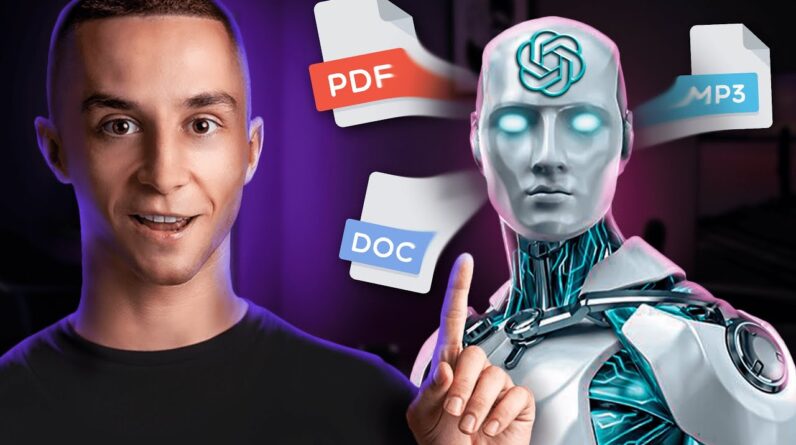
Creating a custom knowledge base chatbot using ChatGPT opens up exciting opportunities for enhancing productivity, especially in a business setting. This guide walks you through the steps of utilizing BerriAI to develop a chatbot capable of interacting with various data formats, such as documents and PDFs. You’ll learn how to integrate your chatbot with Slack, making information retrieval seamless and efficient for your team.
The article highlights the tools and steps necessary for setting up your chatbot, from hosting on Replit to customizing code for your specific needs. By the end, you’ll have a functional chatbot ready to assist with any questions regarding your documents, empowering you and your colleagues to access vital information effortlessly. So, gear up to transform how you communicate with your data!
Table of Contents
Understanding ChatGPT and Its Applications
Overview of ChatGPT’s capabilities
ChatGPT is an impressive AI language model developed by OpenAI that acts as a conversational partner and information source. It’s designed to understand and respond to human language in a coherent, contextually relevant manner. The capabilities of ChatGPT encompass everything from generating engaging text and answering questions to providing summaries and insights on a variety of topics. Whether you’re looking for assistance with drafting emails, brainstorming ideas, or even scripting, ChatGPT can rise to the occasion, effectively making it a versatile tool for personal and professional use.
Potential use cases in business
For businesses, ChatGPT’s potential is substantial. You can deploy it for tasks such as automating customer support, generating reports, creating content, and assisting with data analysis. Imagine having an AI tool that can handle frequently asked questions, guide potential clients through your services, or even generate personalized content for marketing campaigns! The possibilities are endless, allowing business owners and teams to operate more efficiently and focus on more strategic endeavors.
Advantages of using AI in knowledge management
Integrating AI into knowledge management systems introduces numerous advantages. First, it allows for rapid information retrieval and shared access to organizational knowledge, eliminating silos and enhancing collaboration. AI can also analyze vast amounts of data to uncover insights that might otherwise go unnoticed. Additionally, with features like natural language processing, employees can interact with knowledge bases in a more intuitive, conversational manner, leading to higher engagement and reduced training times. Overall, the move toward AI-driven knowledge management paves the way for more informed decision-making and enhanced productivity.
Overview of Custom Knowledge Base Chatbots
Definition of a knowledge base chatbot
A knowledge base chatbot is an AI-driven tool designed to interact with users by retrieving information from a specifically curated repository of data—be it FAQs, documentation, or any other stored knowledge. This kind of chatbot functions as a virtual assistant, allowing users to ask questions in natural language and receive accurate, contextually relevant answers in return. By leveraging structured data and AI capabilities, these chatbots enhance users’ abilities to find and utilize pertinent information quickly.
Importance of customization for businesses
Customization plays a crucial role in the effectiveness of knowledge base chatbots. Businesses operate in diverse industries with varying target audiences and unique sets of information. A one-size-fits-all approach often falls short in providing value. By tailoring a chatbot to reflect your company’s tone, language, and specific knowledge areas, you create a more personalized experience that resonates with users. Moreover, custom knowledge bases enable your chatbot to address industry-specific inquiries and provide targeted information, thereby enhancing customer satisfaction and employee productivity.
Common features of knowledge base chatbots
Knowledge base chatbots typically come equipped with several essential features to maximize efficiency. These often include automated responses to frequently asked questions, real-time information updates, context-aware suggestions, and user engagement tracking. They may also allow document uploads in various formats, such as PDFs and Word documents, facilitating easy access to organizational knowledge. Finally, advanced chatbots can integrate with platforms like Slack, providing seamless communication channels for teams while ensuring information retrieval is as simple as a chat.
Tools for Creating a Custom Knowledge Base Chatbot
Introduction to BerriAI
BerriAI is a powerful tool designed to streamline the process of creating custom knowledge base chatbots. It allows users to upload essential documents that the chatbot can reference while conversing with users. BerriAI’s user-friendly interface makes it accessible even for those who may not consider themselves technically proficient. The platform’s flexibility in handling various data types is one of its standout features, making it well-suited to a range of applications.
Comparison with LangChain and LlamaIndex
When comparing BerriAI with similar tools such as LangChain and LlamaIndex, each has its strengths. LangChain excels in creating modular AI systems and fostering complex workflows, while LlamaIndex offers a unique indexing approach to handling extensive datasets. BerriAI stands out for its ease of use and speed, allowing you to swiftly implement a knowledge base chatbot and start interacting with your documents. The choice among these platforms ultimately depends on your specific requirements and technical capabilities; however, BerriAI often makes the perfect starting point for beginners.
Choosing the right tool for your needs
While there are great tools available for creating custom knowledge base chatbots, selecting the right one for your needs requires consideration of several factors. Are you looking for ease of setup, or do you need advanced functionality? BerriAI might be ideal for simple and rapid deployments, whereas LangChain or LlamaIndex may be more suitable for users seeking complex integrations or advanced configurations. Carefully evaluate your goals, technical skills, and the resources available before making a decision to ensure you maximize the benefit of your chosen tool.
Setting Up Your Custom Knowledge Base
Uploading documents to BerriAI
Setting up your custom knowledge base begins with uploading the relevant documents to BerriAI. The platform’s interface allows you to easily upload files such as text documents, PDFs, and other forms of content that pertain to your knowledge base. Simply log into your BerriAI account, navigate to the designated area for document uploads, and select the files you wish to include. This step lays the groundwork for your chatbot, granting it access to the essential information it will reference while interacting with users.
Creating a relevant custom prompt
Once your documents are uploaded, the next step involves crafting a custom prompt that tailors the chatbot’s responses to your specific needs. A well-structured prompt will give the AI context about the type of information it’s dealing with and the tone it should adopt when answering questions. For example, if you’re building a financial advisory chatbot, your prompt might indicate that the AI should frame its responses as a knowledgeable financial advisor. A relevant prompt significantly enhances the quality of interactions, leading to clearer and more user-centered responses.
Incorporating different data formats (PDFs, Word documents)
One of BerriAI’s unique strengths is its ability to handle various data formats. This flexibility is particularly beneficial for businesses that often work with diverse media types, such as PDFs, Word documents, and even multimedia inputs. Ensure that your uploaded documents are accessible and accurately categorized within your knowledge base. By providing a range of formats, you enhance the integrity and utility of your chatbot, as it can extract and convey information from an expansive set of materials effectively.
Integrating the Chatbot into Slack
Creating a Slack account and app
To integrate your chatbot into Slack, you first need to create a Slack account, which is straightforward and free. Once you have your account set up, navigate to the Slack API portal to create a new application. Upon accessing the portal, click on the ‘Create New App’ button and follow the prompts to set up your application. Give your bot a name and associate it with your workspace. This initial step gets you on the right track to having your very own Slackbot that can interact with your knowledge base seamlessly.

Forking the code project in Replit
The next part of your setup process involves forking the code project on Replit, a popular online IDE. In this environment, you can easily modify the code necessary to connect your Slack app with BerriAI. Once you’ve accessed the project, click the ‘Fork’ button to create your copy. This will allow you to tailor the code to your specifications without affecting the original project. Replit’s user-friendly interface makes it simple to navigate the code, providing clear instructions for further customization.
Adding necessary OAuth scopes for functionality
For your Slackbot to function correctly, you need to add specific OAuth scopes that will allow the bot to interact with channel messages, user data, and more. After forking the code in Replit, head back to the Slack API portal and navigate to the bot settings. Look for the section on OAuth & Permissions and add the necessary scopes, such as sending messages, accessing channels, or reading message history. Ensuring that your bot has the appropriate permissions is crucial for its functionality within your Slack workspace, enabling it to respond to user inputs effectively.
Coding the Chatbot
Implementing API calls to BerriAI
With your Slack app created and configured, you’ll now delve into coding by implementing API calls to BerriAI. This involves integrating your custom chatbot with the API endpoints provided by BerriAI, which allows your bot to query the knowledge base and return relevant answers to users. In the Replit environment, use the appropriate programming language (such as Python or JavaScript) to create functions that handle API communication. This setup can involve setting up HTTP requests, parsing responses, and ensuring that the chatbot integrates smoothly with BerriAI’s features.
Setting up Slack’s event subscriptions
Next, you’ll need to set up Slack’s event subscriptions to allow your bot to respond to user interactions. Navigate to the Slack API dashboard, where you can configure event subscriptions for your application. Here, you’ll specify which events your bot should respond to, such as messages sent in channels or direct messages. By capturing these events, you enable your chatbot to react in real-time, providing immediate assistance to user inquiries based on the knowledge base you’ve created.
Ensuring robust error handling and testing
Coding is often a collaborative process, so it’s essential to ensure that your chatbot is robust. Implementing proper error handling within your code allows it to manage unexpected situations gracefully, like API call failures or user input errors. Furthermore, thorough testing involves interacting with your bot in various scenarios to identify potential issues and rectify them before a full-scale rollout. Testing should encompass all aspects of functionality, ensuring a smooth user experience once your chatbot is live.
Testing and Optimizing Your Chatbot
Performing functional tests on your bot
After completing the setup and coding phases, it’s time to put your chatbot through its paces. Conducting functional tests helps ensure that your bot responds accurately to user queries and utilizes the knowledge base effectively. Interact with your chatbot, ask it various questions, and observe its replies. This phase is essential for gauging how well the bot performs in real-world interactions and will help you identify any areas that require fine-tuning for an optimal user experience.
Gathering feedback for improvements
Once you’ve deployed your chatbot, gathering feedback from users is crucial to its ongoing improvement. Encourage your team members or initial users to interact with the bot and provide insights into their experiences. This feedback loop can help pinpoint what works well and what aspects may need enhancements. Listening to user feedback is vital for adapting your knowledge base chatbot and ensuring it remains relevant and useful over time.
Updating API endpoints for continued compatibility
As technologies evolve, it’s important to ensure your chatbot continues to function seamlessly. Regularly check for updates from BerriAI related to their API endpoints, as changes might affect how your chatbot communicates with the knowledge base. Periodically updating your code to match the latest specifications will help maintain compatibility and ensure your bot’s reliability in delivering accurate information to users.
Exploring Potential Use Cases
Creating centralized knowledge bases for SOPs
Custom knowledge base chatbots can play a pivotal role in organizations by centralizing standard operating procedures (SOPs). By integrating SOPs into a chatbot format, you create an easily accessible resource that employees can reference promptly. This not only streamlines orientation and training processes but also empowers employees to independently find the information they require. In turn, this accessibility enhances overall operational efficiency and adherence to established protocols.
Developing FAQ documentation for customer support
Another practical application of knowledge base chatbots is creating comprehensive FAQ sections. You can upload frequently asked questions and their corresponding answers into your chatbot to provide instant support to customers. This comprehensive repository enables your chatbot to provide accurate information rapidly, significantly enhancing customer experience while reducing the burden on human support staff. With a well-designed FAQ chatbot, you can ensure customers readily receive the assistance they need, elevating their satisfaction levels.
Innovative applications in different industries
The versatility of knowledge base chatbots extends beyond typical applications, allowing you to innovate within different industries. For example, in healthcare, chatbots can assist with medical queries, provide information about procedures, and help manage patient appointments. In education, knowledge base chatbots can offer personalized tutoring support, guiding students through learning materials. The potential applications are virtually limitless, and when tailored to specific sectors, these chatbots can significantly improve operational workflows and enhance user engagement.
Expanding Functionality Beyond Slack
Adapting the code for other messaging platforms
While integrating your chatbot into Slack is a fantastic start, consider adapting the code for other messaging platforms as well. This could include channels like Microsoft Teams, Discord, or Facebook Messenger. The fundamentals of chatbots remain consistent across these platforms, and with slight modifications to the code, your knowledge base chatbot can easily reach users wherever they prefer to communicate. This not only broadens your audience but also enhances accessibility, rendering your knowledge base even more useful.
Using the chatbot for short-form content generation
Beyond standard inquiry handling, your knowledge base chatbot can also serve as a tool for generating short-form content. You can prompt your chatbot to create snippets for social media, draft quick emails, or even summarize lengthy documents. This ability enhances productivity by streamlining content creation processes, allowing team members to focus on higher-level tasks. The adaptability of your chatbot further increases its value as a multifunctional assistant in diverse content-related scenarios.
Ideas for enhancing team productivity through AI
The implementation of a custom knowledge base chatbot can lead to significant improvements in team productivity. By providing instant access to vital information and resources, your chatbot can reduce long search times, streamline communication, and facilitate project collaboration. Furthermore, when integrated with tools like project management software, your chatbot can help automate reminders, deliver updates, and even suggest next steps based on ongoing tasks. Such capabilities provide teams with the resources they need to work efficiently and effectively, fostering a more engaged and productive workforce.
Conclusion
Encouraging viewers to build custom tools
Now that you’ve learned about the ins and outs of developing a custom knowledge base chatbot using ChatGPT and BerriAI, it’s time to take action! Don’t hesitate to explore the possibilities of building your own tools tailored to your specific needs. The knowledge you’ve gathered can transform the way you interact with information, streamline processes, and boost productivity within your organization.
Invitation for feedback on video content
Your journey doesn’t stop here; as you embark on creating your own chatbot, sharing your experiences and feedback is crucial. Whether you faced challenges, discovered innovative solutions, or found ways to optimize your bot, your insights can benefit others in similar ventures. Engaging with fellow creators fosters community and enhances collective learning, ultimately leading to better tools and experiences for everyone involved.
Future directions for knowledge-based chatbot development
As technology continues to evolve, the potential for knowledge-based chatbot development only grows. With advancements in AI, machine learning, and natural language processing, there’s immense potential for creating even more powerful networks of knowledge and user interaction. Looking ahead, consider exploring new integrations, expanding functionality, and refining user interfaces to make your knowledge base chatbot an even more effective part of your operations. The future of interactive assistance holds fantastic opportunities for those ready to innovate and adapt!







